Effects of Prelay Supplementations of Graded Levels of Alphamune G on the Performance of Laying Hens
This study was carried out to determine the effects of age at prelay (15 and 19 weeks) and dietary supplementation of graded levels of Alphamune G (0.00, 0.04, 0.05, 0.06%) on laying performance of pullet chickens. The experiment period was 17 weeks and completely randomized design was employed. Feed intake, nutrient retention, weight gain and feed to gain ratio values were similar (p > 0.05) among birds fed the different dietary inclusion levels of Alphamune G. Hen day production, Haugh unit and Albumen height were significantly high (p < 0.05) for laying hens of fed the control diet. There was also interaction effect of Alphamune G and Age. The interaction of Alphamune G and Age gave the highest value in laying hens of group B fed the 0.05% diet when compared to the control. However, birds fed the 0.06% Alphamune G inclusion level gave the best result in terms of Production characteristics, Cost to benefit ratio expressed as Cost of feed to produce a Dozen Egg and Egg Quality. Also birds of group B gave better results than that of group A except in the Haugh unit value.
Keywords: Alphamune RG, pullet- laying hens, diet
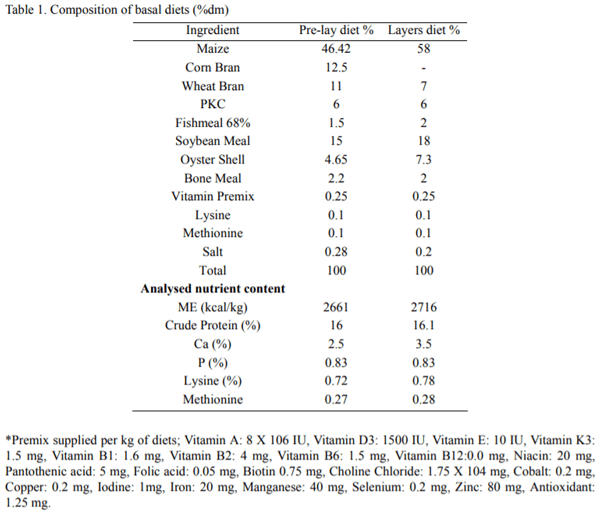
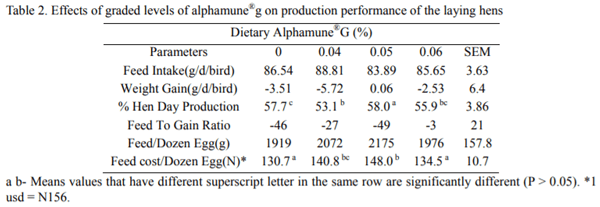
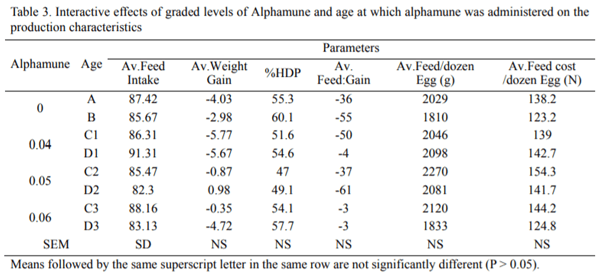

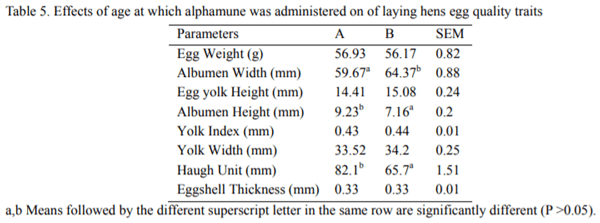
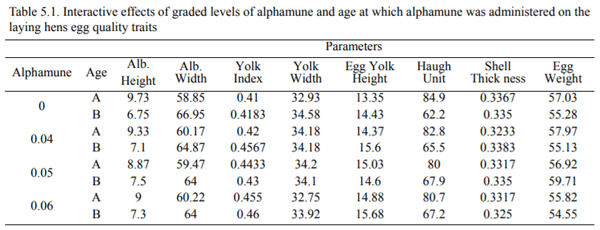


A. O. A. C. (1990). Association of official Analytical Chemists (15th ed.). Official Method of Analysis. Washington, DC.
Alpharma Animal Health. (2004). Alphamune G. For poultry. Retrieved from http://www.thepoultrysite.com/articles/722/alpham une-g-data-sheet
Applegate, T., Ladwig, J. E., Weissert, L., & Lilburn, M. S. (1999). Effect of hen age on intestinal development and glucose tolerance of the Pekin duckling. Poultry Science, 78, 1485-1492.
Atteh, J. O., & Leeson, S. (1985). Response of laying hens to dietary saturated and unsaturated fatty acids in the presence of varying dietary calcium levels. Poultry Science, 64, 520-528. http://dx.doi.org/10.3382/ps.0640520
Bare, A., & Striem, S. V. (1998). Effects of age at onset of production, light regime and dietary calcium on performance, eggshell traits, duodenal calbindin and cholecalciferol metabolism. British Poultry Science, 39, 282-290. http://dx.doi.org/10.1080/00071669889268
Bent, B., & Jessen, B. B. (2000). Possible ways of modifying type and amount of products from microbial fermentation in the gut. 8th Symposium on Digestive Physiology in Pigs. Workshop on: Gut Environment. Influence of luminal factors (pp. 12-14), Uppsala, Sweden.
Bolu, S. A., Ojo, V., Oluyemi, O., Babawale, O. I., & Awodele, O. A. (2009). Effects of graded levels Alphamune G on the performance, blood chemistry and histology of cockerel chicks. International Journal Poultry Science, 8(4), 397-400. http://dx.doi.org/10.3923/ijps.2009.397.400
Bolu, S. A., Olatunde, O. A., & Ojo, V. (2011). Effect of dietary intervention on the performance and biochemical indices of chicken broilers challenged with Aspergillus flavus. Research Opinions in Animal and Veterinary Sciences, 1(5), 292-296.
Bolu, S. A., Ojo, V., Oyeleke, B. A., Ajiboye, A. O., Sambo, A., & Oluyemi, O. (2009). Effects of Alphamune G on the performance, chemistry and Histology of Broilers. International Journal Poultry Science, 8, 32-34.
Dhawale, A. (2005). Better eggshell quality with a gut acidifier-Also offering promise as a substitute for antimicrobial growth promoters, the use of a gut acidifier improved eggshell quality on a broiler breeder farm. Poultry International, 44(4), 18-21.
Duncan, D. B. (1955). Multiple range and multiple F. Test. Biometrics, 11, 1-42. http://dx.doi.org/10.2307/3001478
Hyden, M. (2000). Protected acid additives. Feed International, 7, 14-16.
Leeson, S., Summers, J. D., & Caston, L. J. (1998). Performance of white and brown egg pullets fed varying levels of diet Protein with Constant Sulfur Amino Acids, Lysine and Tryptophan. Journal of Applied Poultry Research, 7(3), 287-301.
Mahdavi, A. H., Rahmani, H. R., & Pourreza, J. (2005). Effect of probiotic supplements on egg qualiity and laying hen’s performance. International Journal Poultry Science, 4, 488-492. http://dx.doi.org/10.3923/ijps.2005.488.492
NRC. (1994). Nutrient requirements of poultry (9th ed.). Washington. D.C: National Academy Press.
Oyejola, B. A. (2003). Design and Analysis of Experiment for Biology and Agriculture students. Olad publishers. Ilorin, Kwara, State, Nigeria.
Petersen, C. F. (1965). Factors influence egg shell quality.1995, A review. World Poultry Science Journal, 21, 110-138. http://dx.doi.org/10.1079/WPS19650013
Samik, K. P., Gobinda, H., Manas, K. M., & Gautam, S. (2007). Effect of organic acid salt on the performance and gut health of broiler chicken. Journal of Poultry Science, 44, 389-395. http://dx.doi.org/10.2141/jpsa.44.389
Schafer, C. M., Corsiglia, C. M., Mireles, A. Jr., & Koutsos, E. A. (2005).Turkey breeder hen age affects growth and systemic and intestinal inflammatory responses in female poults examined at different ages post-hatch. Journal of Applied Poultry Research, 14, 258-264.
Steel, R. D. G., & Torrie, J. H. (1980). Principles and Procedures of Statistics: A Biometrical Approach (2nd ed.). McGraw Hill Book Company, New York, USA.
Toussant, M. J., & Latshaw, J. D. (1999). Ovomucin contents and composition in chicken eggs with different interior quality. Journal of Science, Food and Agriculture, 79, 1666-1670. http://dx.doi.org/10.1002/(SICI)1097-0010(199909)79:12<1666::AID-JSFA416>3.0.CO;2-H
Walsh, T. J., Rizk, R. E., & Brake, J. (1995). Effects of temperature and carbon dioxide on albumen characteristics, weight loss, and early embryonic mortality of long stored hatching eggs. Poultry Science, 74, 1403-1410. http://dx.doi.org/10.3382/ps.0741403








.jpg&w=3840&q=75)